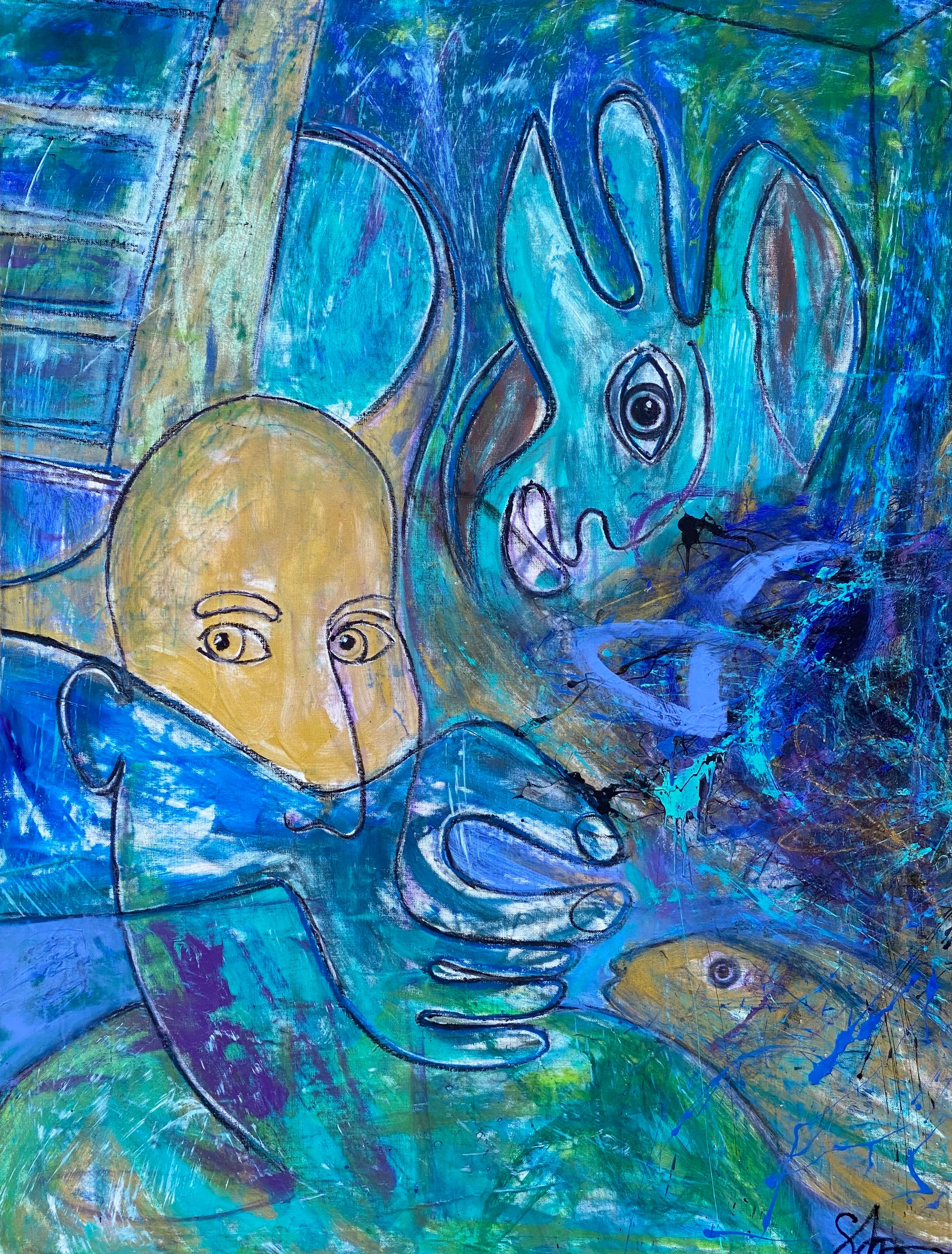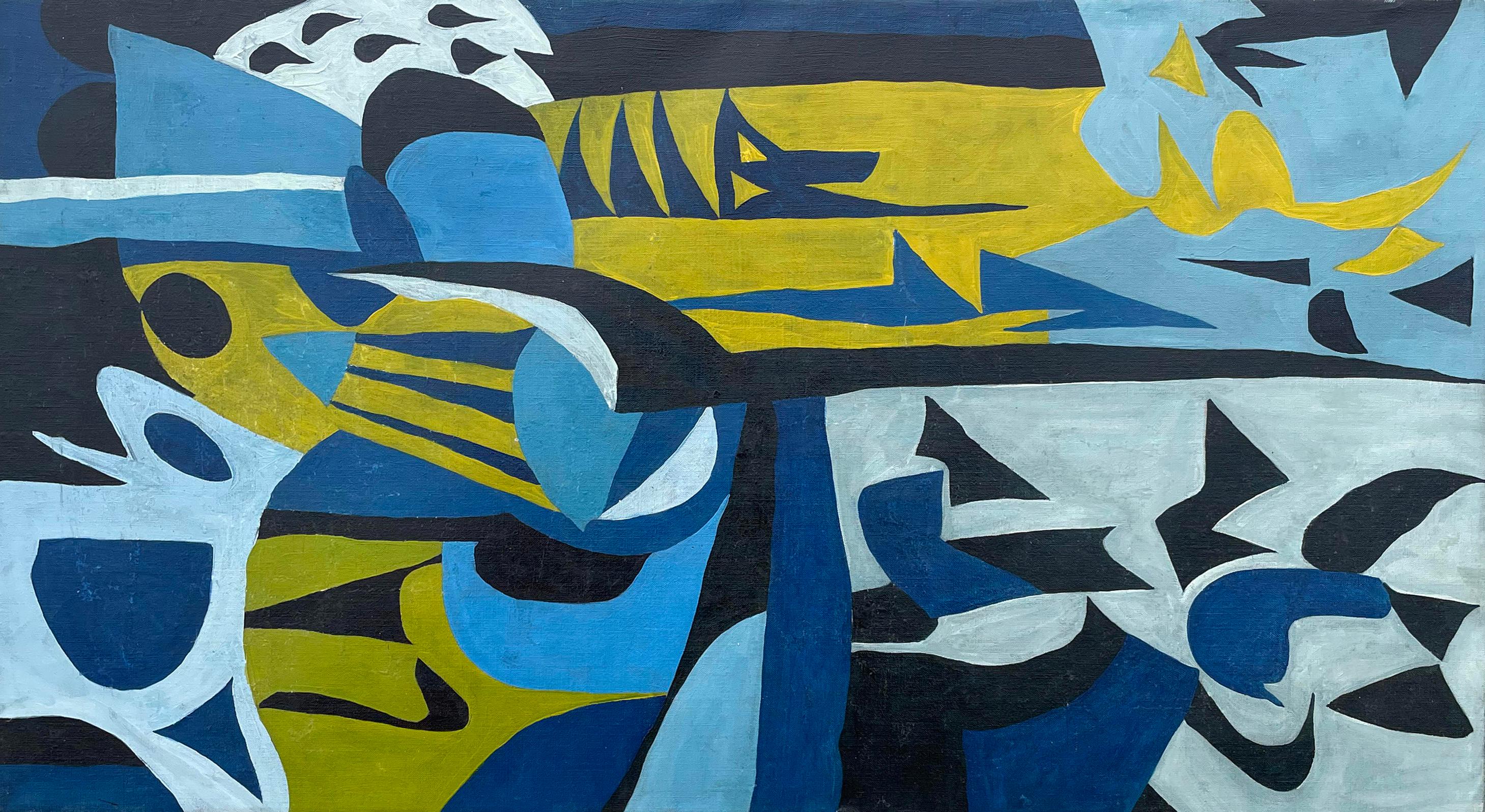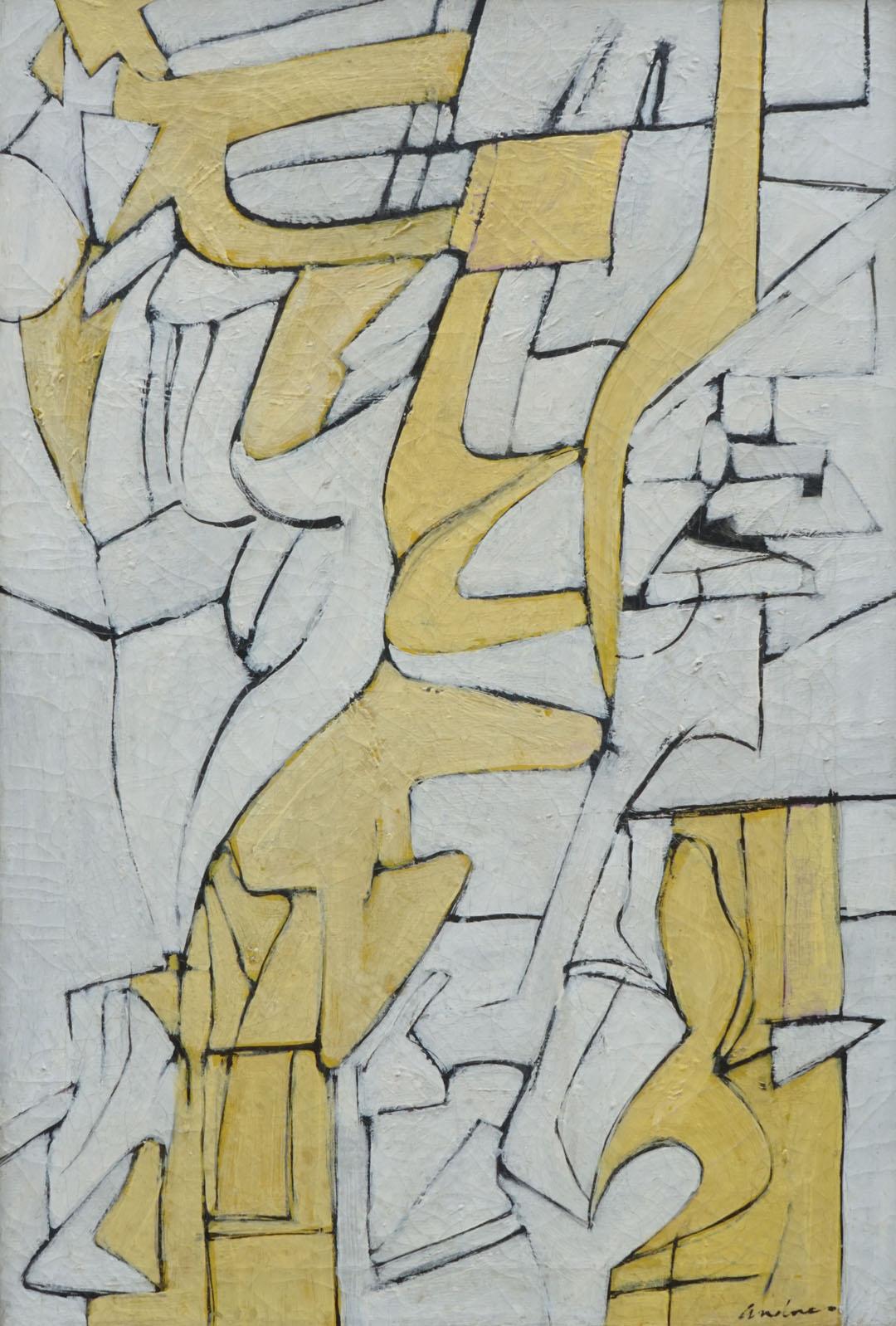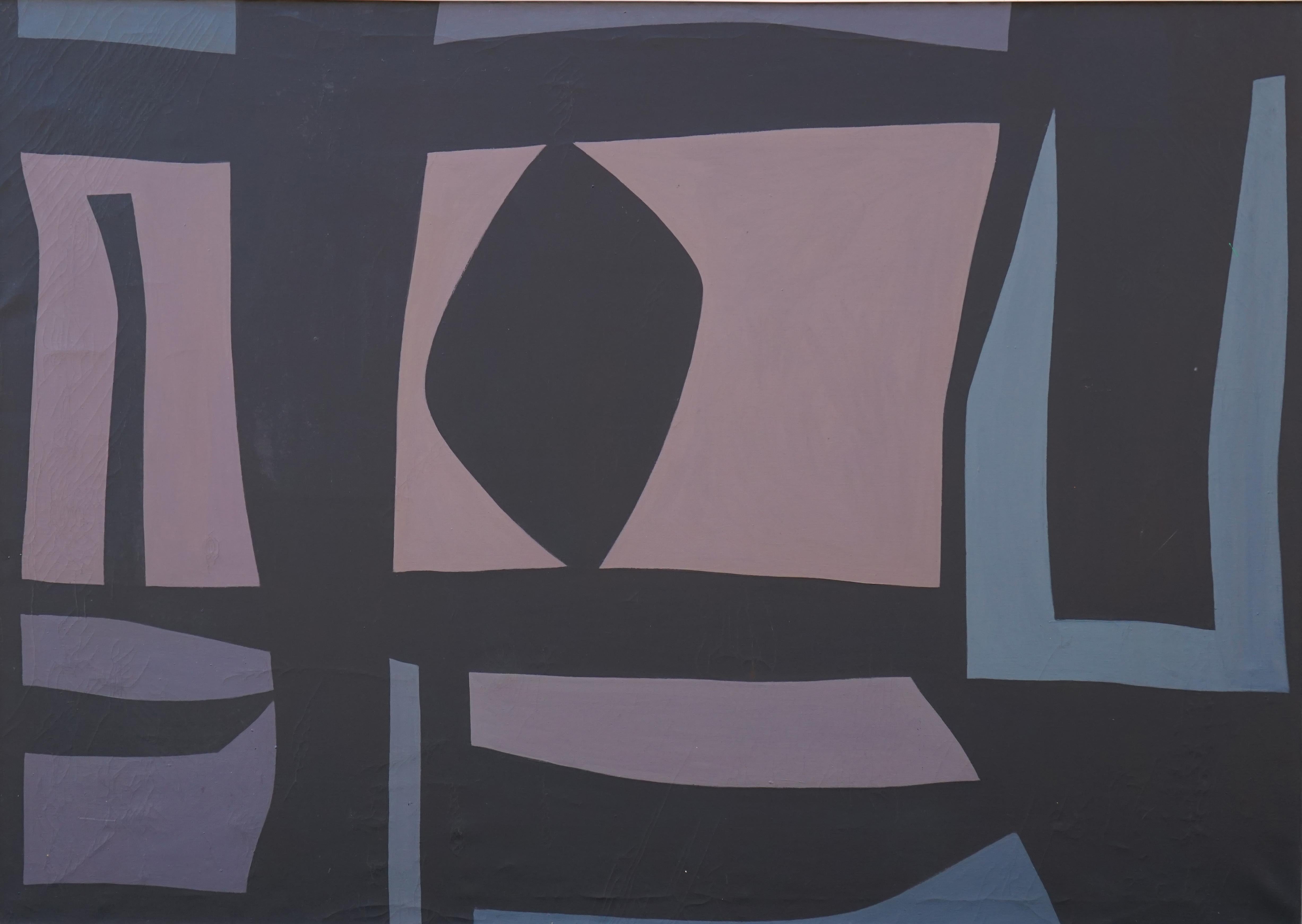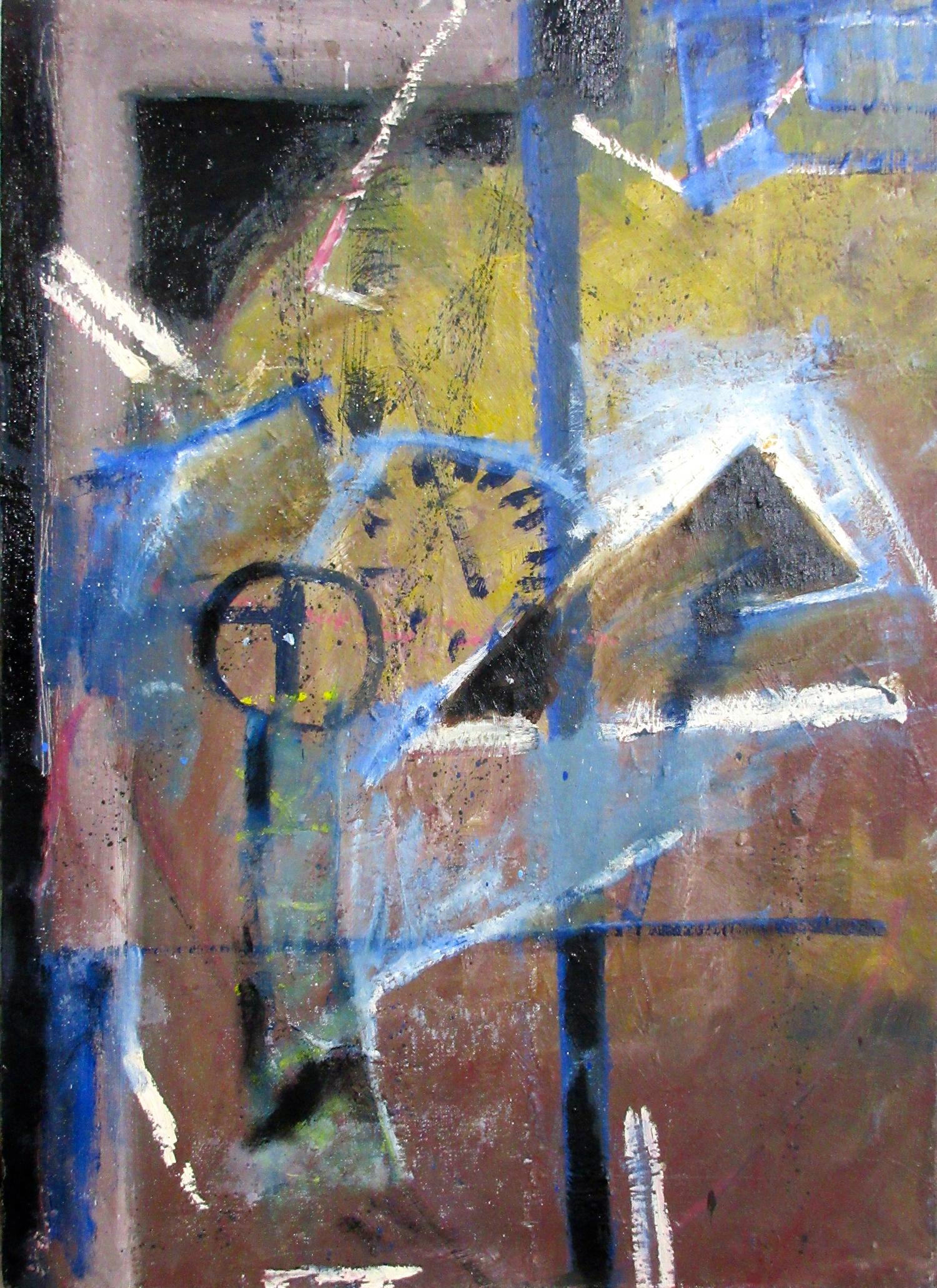Items Similar to "Lovender" - 1979, Abstract Expressionist Oil on Masonite
Want more images or videos?
Request additional images or videos from the seller
1 of 9
John Thompson"Lovender" - 1979, Abstract Expressionist Oil on Masonite1979
1979
About the Item
"Lovender" - 1979, Abstract Expressionist Oil on Masonite
1979 Original abstract expressionist painting by John O. Thomson (American, b. 1941). Purples, pinks and yellows make up this unique abstracted piece.
Signed, titled and dated "J. Thomson" lower right, "Lovender, 1979" on verso.
Presented in original painted wood frame.
Frame: 29"H x 23"L.
Image: 28"H x 22"L.
John O. Thomson is a Bay Area artist. Thompson lived between Santa Cruz, California and Mexico, while working with several of California's designers and art galleries. Thomson studied at the California College of Arts and Crafts, where he was awarded the Bachelor of Arts Degree, Master of Arts Degree, and California Teaching Credentials at Chico State University. He received his Master of Fine Arts Degree in Painting from the University of Guanajuato in Mexico and went on to teach at many institutes.
Thomson has exhibited in many galleries and shows throughout the world including: The Galleria Design Center in San Francisco, The Institute Allende Masters Show, Art Center of Saratoga, The Triton Museum of Santa Clara, The Northern California Art Exhibition, and the Castle Gallery and Cooper House Gallery of Santa Cruz, California.
John Thomson has also exhibited his artwork in many hotels, some of which include The Saint Francis Hotel in San Francisco, The Regency Hotel, and the Sheraton Palace Hotel. As well as teaching art, Thomson has also been a member of the Society of Western Artists, the El Dorado Artists Association, and the San Miguel Artists Association. His work is represented in numerous countries as well as Australia, Belgium, Brazil, Bora Bora, Canada, England, France, Denmark, Japan, Holland, Guatemala, Mexico, New Zealand, Switzerland and Venezuela.
- Creator:John Thompson (1941, American)
- Creation Year:1979
- Dimensions:Height: 29 in (73.66 cm)Width: 23 in (58.42 cm)Depth: 2 in (5.08 cm)
- Medium:
- Movement & Style:
- Period:
- Condition:Excellent condition.
- Gallery Location:Soquel, CA
- Reference Number:
About the Seller
5.0
Platinum Seller
These expertly vetted sellers are 1stDibs' most experienced sellers and are rated highest by our customers.
Established in 1986
1stDibs seller since 2014
2,513 sales on 1stDibs
Typical response time: <1 hour
- ShippingRetrieving quote...Ships From: Soquel, CA
- Return PolicyA return for this item may be initiated within 14 days of delivery.
More From This SellerView All
- Psychedelic Abstract Interior in Oil on PaperLocated in Soquel, CAPsychedelic Abstract Interior in Oil on Paper Moody abstract by Jennie T. Rafton (American, b. 1925). There is a figure in the upper left corner of this piece, looking out over the scene. There appear to be architectural elements such as windows, doors, and stairs, but the composition is highly abstracted, bordering on psychedelic. Of particular note are the symbols inscribed into the yellow shape in the lower left corner. Inscribed in the lower right corner and acquired with a collection of the artist's work. Presented in a new white mat. Mat size: 20"H x 16"W Jennie T. Rafton (American, b. 1925) is a well-known California artist, primarily for her abstract compositions. She and her husband Michael were ardent supporters of the arts, especially the Oakland Symphony Guild. Exh: 1982 - Magnin Gallery (solo), Walnut Creek...Category
Late 20th Century Abstract Expressionist Abstract Paintings
MaterialsOil, Paper
- Dreaming in the BlueLocated in Soquel, CAA beautiful vibrant abstract painting with colors of green, red, blue and yellow dominating the canvas with a teal square focal point outlined in white. Signed illegibly lower right....Category
Mid-20th Century Abstract Abstract Paintings
MaterialsCanvas, Oil
- Dynamic Primary Geometric AbstractBy Ross H. PolletteLocated in Soquel, CAColorful and dynamic oil abstracted geometric composition by Ross H. Pollette also paints under the pseudonyms 'Max West' (American, b. 1948), circa 1980. Un...Category
1980s Abstract Geometric Abstract Paintings
MaterialsCanvas, Oil
- In The Artist's Studio AbstractBy D.S. SilverLocated in Soquel, CALarge scale abstract painting of another abstract painting on artist's easel by California artist D. Silver (American, 20th Century), 1984. Signed and dated lower right corner and on...Category
1980s Abstract Abstract Paintings
MaterialsCanvas, Acrylic
- "After Image" Contemporary Abstract InteriorBy Narcissus Robert QuagliataLocated in Soquel, CASaturated, intimate depiction of sharing a bed with a partner by Narcissus Robert Quagliata (Italian-American, b. 1942). Likely based on an out of focus photograph, this piece stradd...Category
1960s Post-Modern Abstract Paintings
MaterialsCanvas, Oil
- Contemporary Interior Perspective Abstract with Purple & YellowBy Michael William EgglestonLocated in Soquel, CAContemporary Interior Perspective Abstract with Purple & Yellow Stunning interior with and abstracted sense of perspective by San Francisco artist Michael William Eggleston (Americ...Category
Early 2000s Contemporary Abstract Paintings
MaterialsCanvas, Oil
You May Also Like
- "FLYING CHAIR TWO" Abstract Painting 79" x 59" inch by TOMA STENKOLocated in Culver City, CA"FLYING CHAIR TWO" Abstract Painting 79" x 59" inch by TOMA STENKO Toma Stenko’s powerful, often large-scale works balance movement and stillness, colour ...Category
21st Century and Contemporary Abstract Expressionist Abstract Paintings
MaterialsAcrylic, Canvas, Oil Pastel, Oil
- Magic Garden, vibrant mid-century abstract expressionist colorful geometric workBy Richard AndresLocated in Beachwood, OHRichard Andres (American, 1927-2013) Magic Garden, c. 1962 oil on canvas signed lower left, signed and titled verso 50 x 42 inches Richard Andres was born in Buffalo, New York in 19...Category
1960s Abstract Expressionist Abstract Paintings
MaterialsOil
- Abstract expressionist blue, black & green mid-century geometric paintingBy Richard AndresLocated in Beachwood, OHRichard Andres (American, 1927-2013) Untitled, c. 1949 oil on canvas 18 x 32 inches Richard Andres was born in Buffalo, New York in 1927. A graduate of the Cleveland Institute of Art in 1950, he was immediately drafted and served for two years in the army as a mural painter. He received his Master of Arts from Kent State in 1961. A frequent exhibitor at galleries and museums and winner of multiple May Show prizes, Andres taught art in the Cleveland Public Schools for 28 years, as well as teaching the University of Buffalo, the Cleveland Institute of Art and the Western Reserve University. Very little in Richard Andres’ childhood would have predicted his love of classical music, mid-century-modern architecture and certainly not his lifelong passion for art and in particular abstract art. Richard’s father, Raymond, had no more than a third-grade education, and his mother, Clara, was one of thirteen children – only three of whom lived into adulthood and none of whom attended high school. They lived, when Richard was a boy, in a dingy area of Buffalo, NY in a walk-up apartment situated above a tavern. Raymond and Clara supplemented the income from their factory jobs in the bar downstairs with Raymond playing ragtime on the piano and Clara serving drinks. This often left Richard and his two older brothers at home alone to fend for themselves. The two older boys, Raymond and Russell, were - unlike Richard- rather rough and tumble and entertained themselves with stickball, boxing and the like. Richard, on the other hand, from a very young age liked to draw, or better yet even, to paint with the small set of watercolors he received for Christmas one year. Paper, however, at the height of the depression, was hard to come by. Luckily, Clara used paper doilies as decoration for the apartment and Richard would contentedly paint and then cut up doilies, gluing the pieces together to create collages. At eight-years-old, he discovered the Albright-Knox Museum (then known as the Albright Art Gallery) and spent several hours a week there studying the paintings. He was particularly fond of Charles Burchfield‘s landscapes, enamored with their ‘messiness’ and thinking that they somehow captured more ‘feeling’ than works he was previously familiar with. For his tenth Christmas, he asked for and received a ‘how-to’ paint book by Elliot O’Hare. Through this self-teaching, he assembled the portfolio needed for acceptance to Buffalo Technical High School where he studied Advertising Arts. In his Junior year, he was encouraged to enter a watercolor painting, “Two Barns,” in the national 1944-45 Ingersoll Art Award Contest and was one of twelve grand prize winners – each one winning one hundred dollars. More importantly the painting was exhibited at the Carnegie Institute Galleries, which resulted in his winning a national scholarship to the Cleveland School of Art (The Cleveland Art Institute). He flourished at the art school under the tutelage of faculty members such as Carl Gaertner, as well as that of visiting artists such as William Sommer and Henry George Keller. He would say in later years that Gaertner, in particular, influenced his attitude toward life as well as art. “Gaertner,” Andres said, “believed that there was no need to be a ‘tortured artist’, that an artist should rather enjoy beauty, family, and life in general.” Free to spend his days as he chose, he wandered the Cleveland Art Museum for most of the hours he was not attending classes or painting; the remaining time was spent drinking coffee at a local hangout with art school friends – which is where he met fellow Henry Keller scholarship winner, Avis Johnson. Richard was immediately smitten with Avis, but being rather shy, it took him the entire summer of 1948 to build up his courage to ask her out. Over that summer he ‘thought about Avis’ and worked in a diner to save money. He also used the hundred-dollar prize money won in High School to visit the first Max Beckmann retrospective in the United States at the City Art Museum in St. Louis. Over a half century later he spoke of that exhibit with a reverence usually reserved for spiritual matters, “I walked in and it was like nothing I had ever seen before... the color...It just glowed.” Returning to campus in the Fall, the first thing he did was go to the coffee shop in hopes of finding Avis. He did, and she, upon seeing him, realized that she was also smitten with him. They quickly became known as ‘the couple’ on campus, and a year later, with Richard being drafted for the Korean war, they were quickly married by a Justice of the Peace, celebrating after with family at Avis’s Cleveland home. As a gift, faculty member John Paul Miller designed and made the simple gold wedding ring Avis wore for their 65 years of marriage. During those 65 years neither wavered in their mutual love, nor in the respect they shared for one another’s art. The couple lived in a converted chicken coop in Missouri while Richard was in boot camp. At the camp, he would volunteer for any job offered and one of those jobs ended up being painting road signs. His commander noticed how quickly and neatly he worked and gave him more painting work to do - eventually recommending him for a position painting murals for Army offices in Panama. Until her dying day, Avis remained angry that “The army got to keep those fabulous murals and they probably didn’t even know how wonderful they were.” In Panama, their first son, Mark, was born. After Richard’s discharge in 1953, they moved back to the Cleveland area and used the GI bill to attend Kent State gaining his BA in education. The small family then moved briefly to Buffalo, where Richard taught at the Albright Art School and the University of Buffalo – and their second son, Peter, was born. Richard had exhibited work in the Cleveland May Show and the Butler Art Museum during his art school years, and during the years in Buffalo, his work was exhibited at the gallery he had so loved as a child, the Albright Art Gallery. In 1956, the family moved back to the Cleveland area and Richard began teaching art at Lincoln West High School during the day while working toward his MA in art at Kent State in the evenings. Avis and Richard, with the help of an architect, designed their first home - a saltbox style house in Hudson, Ohio, and in 1958, their third son, Max (after Max Beckmann) was born. Richard enjoyed the consistency of teaching high school as well as the time it gave him to paint on the weekends and during the summer months. In 1961, he received his MA and his daughter, Claire, was born. With a fourth child, the house was much too small, and Avis and Richard began designing their second home. An admirer of MCM architecture, Richard’s favorite example of the style was the Farnsworth house – he often spoke of how the concepts behind this architectural style, particularly that of Mies van der Rohe, influenced his painting. Andres described himself as a 1950’s...Category
1940s Abstract Expressionist Abstract Paintings
MaterialsOil
- Abstract expressionist, white and yellow mid-century modern geometric paintingBy Richard AndresLocated in Beachwood, OHRichard Andres (American, 1927-2013) White & Yellow, c. 1953 oil on canvas signed lower right, signed and titled verso 30 x 20 inches Richard Andres was born in Buffalo, New York in 1927. A graduate of the Cleveland Institute of Art in 1950, he was immediately drafted and served for two years in the army as a mural painter. He received his Master of Arts from Kent State in 1961. A frequent exhibitor at galleries and museums and winner of multiple May Show prizes, Andres taught art in the Cleveland Public Schools for 28 years, as well as teaching the University of Buffalo, the Cleveland Institute of Art and the Western Reserve University. Very little in Richard Andres’ childhood would have predicted his love of classical music, mid-century-modern architecture and certainly not his lifelong passion for art and in particular abstract art. Richard’s father, Raymond, had no more than a third-grade education, and his mother, Clara, was one of thirteen children – only three of whom lived into adulthood and none of whom attended high school. They lived, when Richard was a boy, in a dingy area of Buffalo, NY in a walk-up apartment situated above a tavern. Raymond and Clara supplemented the income from their factory jobs in the bar downstairs with Raymond playing ragtime on the piano and Clara serving drinks. This often left Richard and his two older brothers at home alone to fend for themselves. The two older boys, Raymond and Russell, were - unlike Richard- rather rough and tumble and entertained themselves with stickball, boxing and the like. Richard, on the other hand, from a very young age liked to draw, or better yet even, to paint with the small set of watercolors he received for Christmas one year. Paper, however, at the height of the depression, was hard to come by. Luckily, Clara used paper doilies as decoration for the apartment and Richard would contentedly paint and then cut up doilies, gluing the pieces together to create collages. At eight-years-old, he discovered the Albright-Knox Museum (then known as the Albright Art Gallery) and spent several hours a week there studying the paintings. He was particularly fond of Charles Burchfield‘s landscapes, enamored with their ‘messiness’ and thinking that they somehow captured more ‘feeling’ than works he was previously familiar with. For his tenth Christmas, he asked for and received a ‘how-to’ paint book by Elliot O’Hare. Through this self-teaching, he assembled the portfolio needed for acceptance to Buffalo Technical High School where he studied Advertising Arts. In his Junior year, he was encouraged to enter a watercolor painting, “Two Barns,” in the national 1944-45 Ingersoll Art Award Contest and was one of twelve grand prize winners – each one winning one hundred dollars. More importantly the painting was exhibited at the Carnegie Institute Galleries, which resulted in his winning a national scholarship to the Cleveland School of Art (The Cleveland Art Institute). He flourished at the art school under the tutelage of faculty members such as Carl Gaertner, as well as that of visiting artists such as William Sommer and Henry George Keller. He would say in later years that Gaertner, in particular, influenced his attitude toward life as well as art. “Gaertner,” Andres said, “believed that there was no need to be a ‘tortured artist’, that an artist should rather enjoy beauty, family, and life in general.” Free to spend his days as he chose, he wandered the Cleveland Art Museum for most of the hours he was not attending classes or painting; the remaining time was spent drinking coffee at a local hangout with art school friends – which is where he met fellow Henry Keller scholarship winner, Avis Johnson. Richard was immediately smitten with Avis, but being rather shy, it took him the entire summer of 1948 to build up his courage to ask her out. Over that summer he ‘thought about Avis’ and worked in a diner to save money. He also used the hundred-dollar prize money won in High School to visit the first Max Beckmann retrospective in the United States at the City Art Museum in St. Louis. Over a half century later he spoke of that exhibit with a reverence usually reserved for spiritual matters, “I walked in and it was like nothing I had ever seen before... the color...It just glowed.” Returning to campus in the Fall, the first thing he did was go to the coffee shop in hopes of finding Avis. He did, and she, upon seeing him, realized that she was also smitten with him. They quickly became known as ‘the couple’ on campus, and a year later, with Richard being drafted for the Korean war, they were quickly married by a Justice of the Peace, celebrating after with family at Avis’s Cleveland home. As a gift, faculty member John Paul Miller...Category
1950s Abstract Expressionist Abstract Paintings
MaterialsOil
- Blue Wall, mid-century abstract expressionist, geometric blue, black & pink workBy Richard AndresLocated in Beachwood, OHRichard Andres (American, 1927-2013) Blue Wall, c. 1959 oil on canvas signed and titled verso 42 x 60 inches Richard Andres was born in Buffalo, New York in 1927. A graduate of the Cleveland Institute of Art in 1950, he was immediately drafted and served for two years in the army as a mural painter. He received his Master of Arts from Kent State in 1961. A frequent exhibitor at galleries and museums and winner of multiple May Show prizes, Andres taught art in the Cleveland Public Schools for 28 years, as well as teaching the University of Buffalo, the Cleveland Institute of Art and the Western Reserve University. Very little in Richard Andres’ childhood would have predicted his love of classical music, mid-century-modern architecture and certainly not his lifelong passion for art and in particular abstract art. Richard’s father, Raymond, had no more than a third-grade education, and his mother, Clara, was one of thirteen children – only three of whom lived into adulthood and none of whom attended high school. They lived, when Richard was a boy, in a dingy area of Buffalo, NY in a walk-up apartment situated above a tavern. Raymond and Clara supplemented the income from their factory jobs in the bar downstairs with Raymond playing ragtime on the piano and Clara serving drinks. This often left Richard and his two older brothers at home alone to fend for themselves. The two older boys, Raymond and Russell, were - unlike Richard- rather rough and tumble and entertained themselves with stickball, boxing and the like. Richard, on the other hand, from a very young age liked to draw, or better yet even, to paint with the small set of watercolors he received for Christmas one year. Paper, however, at the height of the depression, was hard to come by. Luckily, Clara used paper doilies as decoration for the apartment and Richard would contentedly paint and then cut up doilies, gluing the pieces together to create collages. At eight-years-old, he discovered the Albright-Knox Museum (then known as the Albright Art Gallery) and spent several hours a week there studying the paintings. He was particularly fond of Charles Burchfield‘s landscapes, enamored with their ‘messiness’ and thinking that they somehow captured more ‘feeling’ than works he was previously familiar with. For his tenth Christmas, he asked for and received a ‘how-to’ paint book by Elliot O’Hare. Through this self-teaching, he assembled the portfolio needed for acceptance to Buffalo Technical High School where he studied Advertising Arts. In his Junior year, he was encouraged to enter a watercolor painting, “Two Barns,” in the national 1944-45 Ingersoll Art Award Contest and was one of twelve grand prize winners – each one winning one hundred dollars. More importantly the painting was exhibited at the Carnegie Institute Galleries, which resulted in his winning a national scholarship to the Cleveland School of Art (The Cleveland Art Institute). He flourished at the art school under the tutelage of faculty members such as Carl Gaertner, as well as that of visiting artists such as William Sommer and Henry George Keller. He would say in later years that Gaertner, in particular, influenced his attitude toward life as well as art. “Gaertner,” Andres said, “believed that there was no need to be a ‘tortured artist’, that an artist should rather enjoy beauty, family, and life in general.” Free to spend his days as he chose, he wandered the Cleveland Art Museum for most of the hours he was not attending classes or painting; the remaining time was spent drinking coffee at a local hangout with art school friends – which is where he met fellow Henry Keller scholarship winner, Avis Johnson. Richard was immediately smitten with Avis, but being rather shy, it took him the entire summer of 1948 to build up his courage to ask her out. Over that summer he ‘thought about Avis’ and worked in a diner to save money. He also used the hundred-dollar prize money won in High School to visit the first Max Beckmann retrospective in the United States at the City Art Museum in St. Louis. Over a half century later he spoke of that exhibit with a reverence usually reserved for spiritual matters, “I walked in and it was like nothing I had ever seen before... the color...It just glowed.” Returning to campus in the Fall, the first thing he did was go to the coffee shop in hopes of finding Avis. He did, and she, upon seeing him, realized that she was also smitten with him. They quickly became known as ‘the couple’ on campus, and a year later, with Richard being drafted for the Korean war, they were quickly married by a Justice of the Peace, celebrating after with family at Avis’s Cleveland home. As a gift, faculty member John Paul Miller designed and made the simple gold wedding ring Avis wore for their 65 years of marriage. During those 65 years neither wavered in their mutual love, nor in the respect they shared for one another’s art. The couple lived in a converted chicken coop in Missouri while Richard was in boot camp. At the camp, he would volunteer for any job offered and one of those jobs ended up being painting road signs. His commander noticed how quickly and neatly he worked and gave him more painting work to do - eventually recommending him for a position painting murals for Army offices in Panama. Until her dying day, Avis remained angry that “The army got to keep those fabulous murals and they probably didn’t even know how wonderful they were.” In Panama, their first son, Mark, was born. After Richard’s discharge in 1953, they moved back to the Cleveland area and used the GI bill to attend Kent State gaining his BA in education. The small family then moved briefly to Buffalo, where Richard taught at the Albright Art School and the University of Buffalo – and their second son, Peter, was born. Richard had exhibited work in the Cleveland May Show and the Butler Art Museum during his art school years, and during the years in Buffalo, his work was exhibited at the gallery he had so loved as a child, the Albright Art Gallery. In 1956, the family moved back to the Cleveland area and Richard began teaching art at Lincoln West High School during the day while working toward his MA in art at Kent State in the evenings. Avis and Richard, with the help of an architect, designed their first home - a saltbox style house in Hudson, Ohio, and in 1958, their third son, Max (after Max Beckmann) was born. Richard enjoyed the consistency of teaching high school as well as the time it gave him to paint on the weekends and during the summer months. In 1961, he received his MA and his daughter, Claire, was born. With a fourth child, the house was much too small, and Avis and Richard began designing their second home. An admirer of MCM architecture, Richard’s favorite example of the style was the Farnsworth house – he often spoke of how the concepts behind this architectural style, particularly that of Mies van der Rohe, influenced his painting. Andres described himself as a 1950’s...Category
1950s Abstract Expressionist Abstract Paintings
MaterialsOil
- Door #1By Robert PetrickLocated in Los Angeles, CADoor #1 1988/89 33 inches x 24 inches oil on canvas Artist Statement: "This is an early work I produced in my studio at 11th street and Ave 'B" NYC. I was working at free expressio...Category
1980s Abstract Expressionist Abstract Paintings
MaterialsCanvas, Oil
Recently Viewed
View AllMore Ways To Browse
Vintage Well
Vintage Weller
Northern California Art
Palace Hotel
Japanese Dutch
Vintage Thompson
Regency Hotel
Saint John Painting
Thompson France
Vintage Brazilian Art
Vintage Australian Art
Vintage Australia Art
Western American Vintage
Vintage American Western
Vintage French Abstract Painting
Vintage Hotel California
Vintage California Oil
Mexico San Miguel
